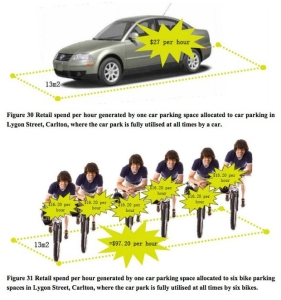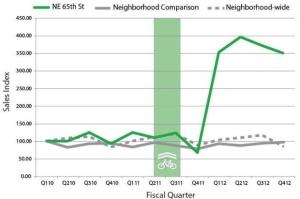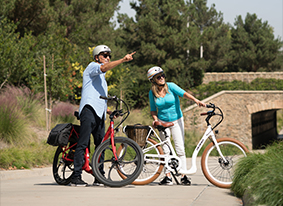More Bike Lanes = Better Business. Here’s Why.
Nelson, British Columbia, the home of Pedego Canada’s headquarters, has suffered a long-standing debate between city councillors, business owners and the general public about on-street parking spaces. Specifically, there’s a divide between those who want to close the downtown shopping district of Baker Street to vehicle traffic and those who insist its parking spaces are good for business.
This notion of lost revenue is somewhat understandable given that people who drive cars have more room to hold lots of purchases. However, since this debate first started in Nelson, studies around the world about the economic impacts of pedestrian malls and creating more bike lanes have been done and, in most instances, prove removing on-street parking has little to no impact on local business, and in some cases it increases business. Yes, cars can load up more goods but cyclists tend to make more trips, which has the cumulative effect of pumping more total money into the local economy over time.
In an article by CityLab, a digital storytelling space owned by the Atlantic Monthly, writer Eric Jaffe looked at 12 different studies conducted in the past decade in cities such as San Francisco, New York, Melbourne, Toronto, Vancouver and Seattle to culminate data. What he found was surprising to shop owners. For example, a study was done by the Clean Air Partnership in Toronto that surveyed 61 merchants and 538 patrons on Bloor Street. It discovered only 10 percent of patrons drove to the shopping area, and those arriving by foot and bicycle spent the most money per month. The report’s authors came to the conclusion that converting the area’s on-street parking into bike lanes “will likely increase commercial activity.” Here’s one of the graphs from the study:
https://pedegoelectricbikes.ca/wp-content/uploads/2017/03/toronto-bike-lane-business-chart-1.jpg
In another study that about the shopping behaviour of bicyclists and drivers in Melbourne, Australia, researcher Alison Lee learned drivers spent $27 per hour compared to $16.20 by cyclists. However, because six bikes can fit into a single automobile parking space the total hourly spending increases to $97.20 Lee said the city would experience an economic gain by giving on-street parking areas over to bike lanes. Here’s one of the charts from her study:
In perhaps one of the most surprising studies, University of Washington researcher Kyle Rowe discovered the sales index on the city’s 65th Street skyrocketed over 400% after a bike lane was put in place. That said, business didn’t spike around a new bike lane in the Greenwood district, but it didn’t fall either. Rowe concluded that cycling infrastructure had no “negative impact” on Seattle business.
To learn about the other studies done around the world and to read the CityLab article in its entirety, click here: “The complete business case for converting street parking into bike lanes.”






